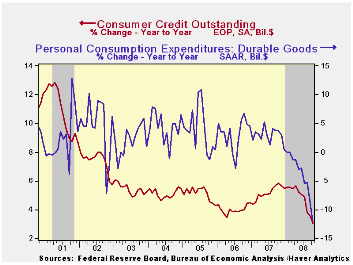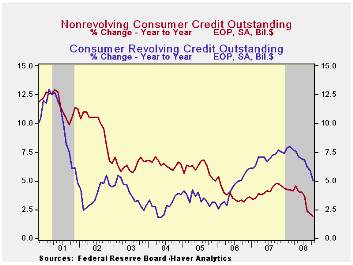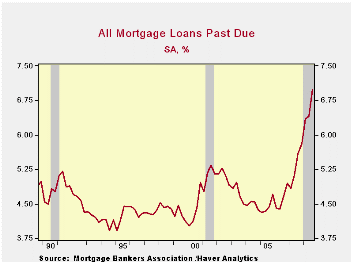 Global| Dec 05 2008
Global| Dec 05 2008U.S. Consumer Credit Usage Down; Mortgage Delinquencies Surge
by:Tom Moeller
|in:Economy in Brief
Summary
The usage of consumer credit continued to fall as it never has before. During October, consumer credit outstanding fell $3.6 billion m/m. Though that lagged a $6.5B decline back in August, it still was one of the largest in the [...]
 The
usage of consumer credit continued to fall as it never has before.
During October, consumer credit outstanding fell $3.6 billion m/m.
Though that lagged a $6.5B decline back in August, it still was one of
the largest in the series' postwar history. On a percentage basis,
credit outstanding over the last three months fell 0.1%, the first
decline since 1992.
The
usage of consumer credit continued to fall as it never has before.
During October, consumer credit outstanding fell $3.6 billion m/m.
Though that lagged a $6.5B decline back in August, it still was one of
the largest in the series' postwar history. On a percentage basis,
credit outstanding over the last three months fell 0.1%, the first
decline since 1992.
Before October, credit growth averaged roughly 5% y/y after the rise of 5.5% during all of 2007. The decline in y/y growth thru October to 3.1% was precipitated by less spending on consumer durables. The annualized growth in nominal PCE for durable goods during the last three months cycled down to -22.4% from 2.9% positive growth during all of last year.
Non-revolving credit, which accounts for nearly two-thirds of total consumer credit, led the October decline in borrowing with a $3.4B drop. The dollar drop was nearly unprecedented. On a three month basis, annualized growth fell to -1.9% after a 4.4% rise last year and 3.6% growth during 2006.
Revolving credit outstanding dropped a more modest $0.2B during October. Indeed, consumers were much more frugal using their credit cards. Three month growth fell to 1.8%, down by more than two thirds from the 7.4% growth last year.
These figures are the major input to the Fed's quarterly Flow of Funds accounts for the household sector. For 4Q08 the data will be released later this month.
These data are available in Haver's USECON database.Delinquent Home Mortgages Up Sharply· For the third quarter, 7% of all mortgages were past due. The increase in lagged payments was up from 6.4% of loans during 2Q, 5.8% last year and 5.0% in 2006. Past due by 30 days were 3.4% of loans versus 3.2% last year and 2.2% were past due by 90 days versus 1.5% during 2007.
Foreclosures were started on 1.1% of loans, down from 1.2% in 2Q. The latest still was up, however, from 0.8% in 3Q of last year and from 0.5% in 3Q06. During all of last year, 2.8% of all mortgage loans went into foreclosure, a record high and up from a norm of 0.2% to 0.4%.
Of conventional prime fixed rate mortgages 3.4% were past due, up from 2.6% last year. The news on ARMs, however, is far worse. The estimate is that 8.2% were delinquent versus 5.5% last year and 3.4% in 2006.
These data are available in Haver's MBAMTG database.


| Consumer Credit (m/m Chg, SAAR) | October | September | Y/Y | 2007 | 2006 | 2005 |
|---|---|---|---|---|---|---|
| Total | $-3.6B | $6.8B | 3.1% | 5.5% | 4.5% | 4.3% |
| Revolving | $-0.2B | $2.5B | 5.0% | 7.4% | 6.1% | 3.1% |
| Non-revolving | $-3.4B | $4.2B | 1.9% | 4.4% | 3.6% | 4.9% |
Tom Moeller
AuthorMore in Author Profile »Prior to joining Haver Analytics in 2000, Mr. Moeller worked as the Economist at Chancellor Capital Management from 1985 to 1999. There, he developed comprehensive economic forecasts and interpreted economic data for equity and fixed income portfolio managers. Also at Chancellor, Mr. Moeller worked as an equity analyst and was responsible for researching and rating companies in the economically sensitive automobile and housing industries for investment in Chancellor’s equity portfolio. Prior to joining Chancellor, Mr. Moeller was an Economist at Citibank from 1979 to 1984. He also analyzed pricing behavior in the metals industry for the Council on Wage and Price Stability in Washington, D.C. In 1999, Mr. Moeller received the award for most accurate forecast from the Forecasters' Club of New York. From 1990 to 1992 he was President of the New York Association for Business Economists. Mr. Moeller earned an M.B.A. in Finance from Fordham University, where he graduated in 1987. He holds a Bachelor of Arts in Economics from George Washington University.






